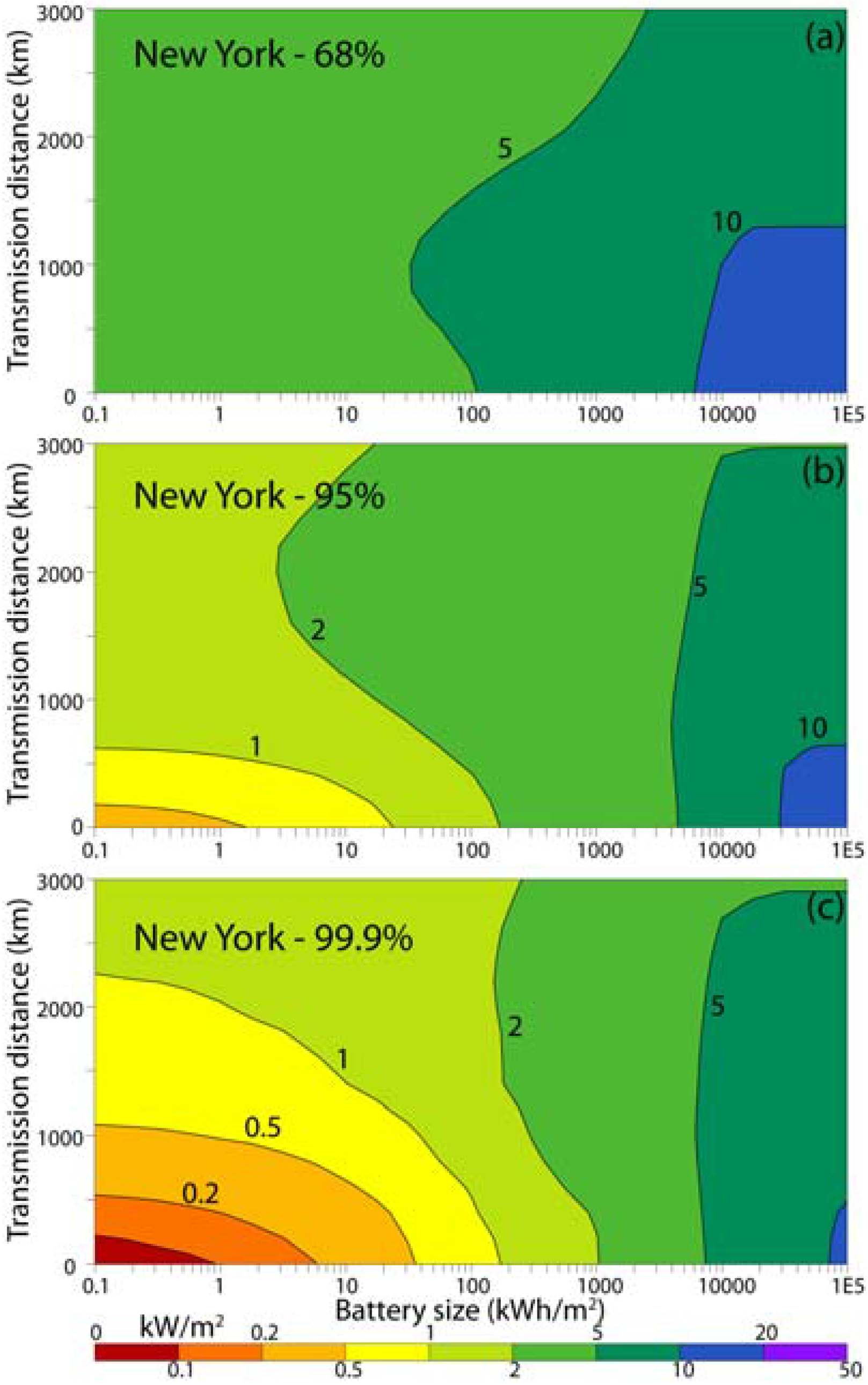Global Assessment of High-Altitude Wind Power
Abstract
:1. Introduction

2. Methods and Data

3. Geographical and Statistical Distributions
3.1. Global Vertical Profiles

3.2. City Vertical Profiles
3.3. Atlas

3.4. Optimal Height

4. Dealing with Intermittency

5. Climate Effects
| Difference from control case | |||
|---|---|---|---|
| Device area (m2/km3) | Mean surface temperature (oC) | Sea ice cover (%) | Total precipitation (%) |
| 1 | -0.04 | +0.45 | -0.12 |


6. Conclusions
Supplementary Files
Supplementary File 1Acknowledgements
References and Notes
- Arya, S. Introduction to micrometeorology; Academic Press: New York, NY, USA, 1988; p. 303. [Google Scholar]
- Koch, P.; Wernli, H.; Davies, H.C. An event-based jet-stream climatology and typology. Int. J. Climatol. 2006, 26, 283–301. [Google Scholar] [CrossRef]
- Roberts, B.W.; Shepard, D.H.; Caldeira, K.; Cannon, M.E.; Eccles, D.G.; Grenier, A.J.; Freidin, J.F. Harnessing high-altitude wind power. IEEE Trans. Energy Convers. 2007, 22, 136–144. [Google Scholar] [CrossRef]
- Canale, M.; Fagiano, L.; Milanese, M. Power Kites for Wind Energy Generation [Applications of Control]. IEEE Control Syst. Mag. 2007, 27, 25–38. [Google Scholar] [CrossRef]
- Ragusa, S.M. Evaluation of energy in high-altitude winds: Kite Gen [in Italian]; Politecnico di Torino: Turin, Italy, 2007; p. 45. [Google Scholar]
- Canale, M.; Fagiano, L.; Milanese, M. KiteGen: A revolution in wind energy generation. Energy 2009, 34, 355–361. [Google Scholar] [CrossRef]
- Masters, G.; Wiley, J.; InterScience, W. Renewable and efficient electric power systems; John Wiley & Sons: Hoboken, NJ, USA, 2004. [Google Scholar]
- Kanamitsu, M.; Ebisuzaki, W.; Woollen, J.; Yang, S.; Hnilo, J.; Fiorino, M.; Potter, G. NCEP–DOE AMIP-II Reanalysis (R-2). Bull. Am. Meteorol. Soc. 2002, 83, 1631–1643. [Google Scholar] [CrossRef]
- Archer, C.; Caldeira, K. Historical trends in the jet streams. Geophys. Res. Lett. 2008, 35, L08803. [Google Scholar] [CrossRef]
- Francis, J. Validation of reanalysis upper-level winds in the Arctic with independent rawinsonde data. Geophys. Res. Lett. 2002, 29, 1315. [Google Scholar] [CrossRef]
- Archer, C.; Jacobson, M. Spatial and temporal distributions of US winds and wind power at 80 m derived from measurements. J. Geophys. Res. 2003, 108, 4289. [Google Scholar] [CrossRef]
- Archer, C.L.; Jacobson, M.Z. Corrections to “Spatial and temporal distribution of US winds and wind power at 80 m derived from measurements”. J. Geophys. Res. 2004, 109, 1–11. [Google Scholar]
- Argatov, I.; Rautakorpi, P.; Silvennoinen, R. Estimation of the mechanical energy output of the kite wind generator. Renewable Energy 2009, 34, 1525–1532. [Google Scholar] [CrossRef]
- O'Doherty, R.J.; Roberts, B.W. Application of US upper wind data in one design of tethered wind energy systems; Technical Report; Solar Energy Research Inst.: Golden, CO, USA, 1982; p. 133. [Google Scholar]
- Hsieh, Y. On the wind and temperature fields over western Pacific and eastern Asia in winter. J. Chin. Geophys. Soc 1951, 2, 279–297. [Google Scholar]
- Kung, E.C.; Chan, P.H. Energetics Characteristics of the Asian Winter Monsoon in the Source Region. Mon. Weather Rev. 1981, 109, 854–870. [Google Scholar] [CrossRef]
- Stull, R. An introduction to boundary layer meteorology; Springer: New York, NY, USA, 1988; p. 670. [Google Scholar]
- Chen, W.; Lui, E. Handbook of structural engineering; CRC Press: Boca Raton, FL, USA, 2005; p. 1768. [Google Scholar]
- Cadet, D. Meteorology of the Indian summer monsoon. Nature 1979, 279, 761–767. [Google Scholar] [CrossRef]
- Stensrud, D. Importance of low-level jets to climate: A review. J. Clim. 1996, 9, 1698–1711. [Google Scholar] [CrossRef]
- Archer, C.L.; Jacobson, M.Z. Supplying baseload power and reducing transmission requirements by interconnecting wind farms. J. Appl. Meteorol. climatol. 2007, 46, 1701–1717. [Google Scholar] [CrossRef]
- Burton, T.; Sharpe, D.; Jenkin, N.; Bossanyi, E. Wind energy handbook; John Wiley and Sons: Chichester, U.K., 2001; p. 617. [Google Scholar]
- Collins, W.; Blackmon, M.; Bitz, C.; Bonan, G.; Bretherton, C.; Carton, J.; Chang, P.; Doney, S.; Hack, J.; Kiehl, J. The Community Climate System Model: CCSM3. J. Clim. 2006, 19, 2122–2143. [Google Scholar] [CrossRef]
- Keith, D.; DeCarolis, J.; Denkenberger, D.; Lenschow, D.; Malyshev, S.; Pacala, S.; Rasch, P. The influence of large-scale wind power on global climate. Proc. Nat. Acad. Sci. 2004, 101, 16115–16120. [Google Scholar] [CrossRef] [PubMed]
© 2009 by the authors; licensee Molecular Diversity Preservation International, Basel, Switzerland. This article is an open-access article distributed under the terms and conditions of the Creative Commons Attribution license (http://creativecommons.org/licenses/by/3.0/).
Share and Cite
Archer, C.L.; Caldeira, K. Global Assessment of High-Altitude Wind Power. Energies 2009, 2, 307-319. https://doi.org/10.3390/en20200307
Archer CL, Caldeira K. Global Assessment of High-Altitude Wind Power. Energies. 2009; 2(2):307-319. https://doi.org/10.3390/en20200307
Chicago/Turabian StyleArcher, Cristina L., and Ken Caldeira. 2009. "Global Assessment of High-Altitude Wind Power" Energies 2, no. 2: 307-319. https://doi.org/10.3390/en20200307
APA StyleArcher, C. L., & Caldeira, K. (2009). Global Assessment of High-Altitude Wind Power. Energies, 2(2), 307-319. https://doi.org/10.3390/en20200307




